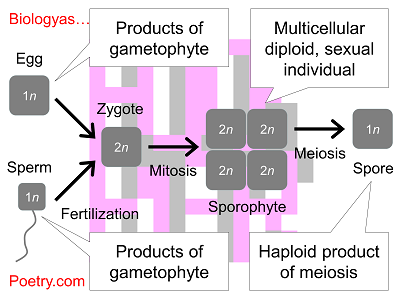∞ generated and posted on 2016.08.30 ∞
Diploid multicellular organism that produces spores.
More generally, this is the diploid generation in alternation of generations. That is, alternation of generations is not exclusive to plants since it is seen in various algae as well. In the latter case it is generally zoospores that are produced rather than strictly spores.
In primitive plants the sporophyte generation is the less inconspicuous plant generation. In mosses the sporophyte plants look like little lamp posts and these plants, though genetically distinct from their gametophyte parents, just as you are genetically distinct from your parents, nonetheless are nutritionally dependent on the maternal plant they are found in association with and within which they germinate.
For most plants, though, when you think of plants you are thinking of the sporophyte generation, e.g., trees. This is because in all vascular plants the sporophyte generation is much larger and therefore more conspicuous than the much smaller gametophyte generation.

Figure legend: The sporophyte – the diploid, multicellular generation of alternation of generations – is produced via the fusion of sperm and egg. As such, the zygote is the first cell of this generation. The multicellular organism is then generated via mitosis, i.e., asexual cell division. Subsequently a subset of the organism's cells undergo meiosis, generating the haploid spores. These spores constitute the first cell of the gametophyte generation. The sporophyte generation is named that because it is the generation that produces the spores.
In seed-bearing plants, all of which also are vascular plants, the maternal gametophyte is completely dependent on and found in association with the sporophyte plant. The paternal gametophyte, in turn, is literally pollen.